
Handel House Museum
Encyclopedia
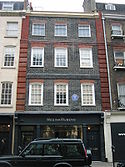
Mayfair
Mayfair is an area of central London, within the City of Westminster.-History:Mayfair is named after the annual fortnight-long May Fair that took place on the site that is Shepherd Market today...
, London
London
London is the capital city of :England and the :United Kingdom, the largest metropolitan area in the United Kingdom, and the largest urban zone in the European Union by most measures. Located on the River Thames, London has been a major settlement for two millennia, its history going back to its...
dedicated to the life and works of the German
Germany
Germany , officially the Federal Republic of Germany , is a federal parliamentary republic in Europe. The country consists of 16 states while the capital and largest city is Berlin. Germany covers an area of 357,021 km2 and has a largely temperate seasonal climate...
born baroque
Baroque music
Baroque music describes a style of Western Classical music approximately extending from 1600 to 1760. This era follows the Renaissance and was followed in turn by the Classical era...
composer George Frideric Handel
George Frideric Handel
George Frideric Handel was a German-British Baroque composer, famous for his operas, oratorios, anthems and organ concertos. Handel was born in 1685, in a family indifferent to music...
, who made his home in London in 1712 and eventually became a British citizen in 1727. Handel was the first occupant of 25 Brook Street
Brook Street
Brook Street is one of the principal streets on the Grosvenor Estate in the exclusive central London district of Mayfair. It was developed in the first half of the 18th century and runs from Hanover Square to Grosvenor Square. The continuation from Grosvenor Square to Park Lane is called Upper...
, which he rented from 1723 until his death there in 1759. Almost all his works after 1723, amongst them many of his best-known operas, oratorios and ceremonial music, were composed and partially rehearsed in the house, which contained a variety of keyboard instruments, including harpsichord
Harpsichord
A harpsichord is a musical instrument played by means of a keyboard. It produces sound by plucking a string when a key is pressed.In the narrow sense, "harpsichord" designates only the large wing-shaped instruments in which the strings are perpendicular to the keyboard...
s, a clavichord
Clavichord
The clavichord is a European stringed keyboard instrument known from the late Medieval, through the Renaissance, Baroque and Classical eras. Historically, it was widely used as a practice instrument and as an aid to composition, not being loud enough for larger performances. The clavichord produces...
and a small chamber organ.
The museum was opened in 2001 by the Handel House Trust as the result of an initiative of the musicologist and Handelian Stanley Sadie
Stanley Sadie
Stanley Sadie CBE was a leading British musicologist, music critic, and editor. He was editor of the sixth edition of the Grove Dictionary of Music and Musicians , which was published as the first edition of the New Grove Dictionary of Music and Musicians.Sadie was educated at St Paul's School,...
in 1959. It comprises a carefully restored set of period rooms on the first and second floors of 25 Brook Street together with exhibition rooms in number 23, the adjacent house on the terrace.
The museum

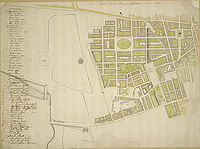
Stanley Sadie
Stanley Sadie CBE was a leading British musicologist, music critic, and editor. He was editor of the sixth edition of the Grove Dictionary of Music and Musicians , which was published as the first edition of the New Grove Dictionary of Music and Musicians.Sadie was educated at St Paul's School,...
in 1959, at a party held there by the fashion company Viyella
Viyella
Viyella was a blend of wool and cotton first woven in 1893 in England, and soon to be the "first branded fabric in the world". It was made of 55 percent merino wool and 45 percent cotton in a twill weave, developed by James and Robert Sissons of William Hollins & Company, spinners and hosiers...
to commemorate the bicentenary of Handel's death. After a further 30 years, in the early 1990s Sadie and his wife Julie Anne set up the Handel House Trust, the charity which oversaw the conversion of the house into a museum.
The house has been restored to look as it did during Handel's 36 year occupancy from 1723 to 1759. A typical early 18th century London terrace house, it comprises a basement, three main storeys and an attic, and Handel was the first occupant. The attic was later converted into a fourth full floor. The ground floor is a shop not associated with the Museum, and the upper floors are leased to a charity called the Handel House Trust, and have been open to the public since 8 November 2001.
The interiors have been restored to the somewhat spartan style of the Georgian era, using mostly architectural elements from elsewhere, since, apart from the staircase, few of the original interior features survived.
The Handel House Collection Trust has assembled a collection of Handel memorabilia, including the Byrne Collection of several hundred items, which was acquired in 1998.
History



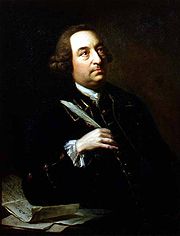
George II of Great Britain
George II was King of Great Britain and Ireland, Duke of Brunswick-Lüneburg and Archtreasurer and Prince-elector of the Holy Roman Empire from 11 June 1727 until his death.George was the last British monarch born outside Great Britain. He was born and brought up in Northern Germany...
as composer to the Chapel Royal
Chapel Royal
A Chapel Royal is a body of priests and singers who serve the spiritual needs of their sovereign wherever they are called upon to do so.-Austria:...
, for which he was paid £400 per annum. The house had been newly built with Nos. 23, 27/29 and 31 by George Barnes as part of the planned extension of Brook Street, linking Hanover Square
Hanover Square, London
Hanover Square, London, is a square in Mayfair, London W1, England, situated to the south west of Oxford Circus, the major junction where Oxford Street meets Regent Street....
with Grosvenor Square
Grosvenor Square
Grosvenor Square is a large garden square in the exclusive Mayfair district of London, England. It is the centrepiece of the Mayfair property of the Duke of Westminster, and takes its name from their surname, "Grosvenor".-History:...
, between 1717 and 1726. Originally, as a foreign national, Handel was not eligible to buy or take long term leases on property in London; and even when he acquired British nationality in 1727, Handel continued renting the property on short term leases. The fact that he remained there for the rest of his life, almost 40 years, is remarkable, since opera composers at the time were rarely of fixed abode
No fixed abode
No fixed abode or without fixed abode is a legal term generally applied to those who do not have a fixed geographical location as their residence...
; prior to that, Handel had been lodged in the homes of friends and patrons. At the age of 38, Handel had become accepted within the higher echelons of British society, with whom he freely mixed. His immediate neighbours on either side were from the upper middle classes and initially included the Member of Parliament
Member of Parliament
A Member of Parliament is a representative of the voters to a :parliament. In many countries with bicameral parliaments, the term applies specifically to members of the lower house, as upper houses often have a different title, such as senate, and thus also have different titles for its members,...
, John Monckton, who later became the first Viscount Galway
Viscount Galway
Viscount Galway is a title that has been created once in the Peerage of England and thrice in the Peerage of Ireland. The first creation came in the Peerage of England in 1628 in favour of Richard Burke, 4th Earl of Clanricarde. He was made Earl of St Albans at the same time...
in 1727.
The layout of the rooms followed the conventions for a modest Georgian
Georgian architecture
Georgian architecture is the name given in most English-speaking countries to the set of architectural styles current between 1720 and 1840. It is eponymous for the first four British monarchs of the House of Hanover—George I of Great Britain, George II of Great Britain, George III of the United...
townhouse: the basement contained the kitchens; on each of the three floors above, there was a front room and a smaller back room with an adjacent closet; under the roof were garret
Garret
A garret is generally synonymous in modern usage with a habitable attic or small living space at the top of a house. It entered Middle English via Old French with a military connotation of a watchtower or something akin to a garrison, in other words a place for guards or soldiers to be quartered...
s for servants.
The larger front first room was used for rehearsal and probably contained a harpsichord
Harpsichord
A harpsichord is a musical instrument played by means of a keyboard. It produces sound by plucking a string when a key is pressed.In the narrow sense, "harpsichord" designates only the large wing-shaped instruments in which the strings are perpendicular to the keyboard...
and a small house chamber organ. The museum currently contains a reproduction of a period harpsichord of the Flemish firm Ruckers
Ruckers
The Ruckers family were Flemish harpsichord and virginal makers based in Antwerp in the 16th and 17th century whose influence stretched well into the 18th and to the harpsichord revival of the 20th.The Ruckers family contributed immeasurably to the harpsichord's technical development,...
; a reproduction of a period chamber organ, based on the designs of the
organbuilders Richard Bridge and Thomas Parker, was made for the Handel House Trust in 1998 and can be seen in Handel's parish church, St George's, Hanover Square, round the corner from Brook Street.
From the 1730s onwards there are many references to rehearsals of operas and oratorios at Brook Street by Handel's friends and fellow musicians. Listening to a rehearsal of Alcina
Alcina
Alcina is an opera seria by George Frideric Handel. Handel used the libretto of L'isola di Alcina, an opera that was set in 1728 in Rome by Riccardo Broschi, which he acquired the year after, during his travels in Italy...
with the soprano Anna Maria Strada
Anna Maria Strada
Anna Maria Strada was an Italian soprano of the 18th century. She is best remembered for her association with the composer George Frideric Handel, in whose operas Strada sang.-Career:...
, Mrs Pendarves commented, "Whilst Mr Handel was playing his part, I could not help thinking him a necromancer in the midst of his enchantments." The Messiah
Messiah
A messiah is a redeemer figure expected or foretold in one form or another by a religion. Slightly more widely, a messiah is any redeemer figure. Messianic beliefs or theories generally relate to eschatological improvement of the state of humanity or the world, in other words the World to...
was also rehearsed there; the lead violinist Abraham Wilson recounted to the musicologist Charles Burney
Charles Burney
Charles Burney FRS was an English music historian and father of authors Frances Burney and Sarah Burney.-Life and career:...
"how civilly he had been attended by him [Handel] to the door, and how carefully cautioned, after being heated by a crowded room and hard labour, at the rehearsal in Brook-street, not to stir without a [Sedan] chair."
The adjacent room at the rear of the house was Handel's composing room and probably contained Handel's clavichord
Clavichord
The clavichord is a European stringed keyboard instrument known from the late Medieval, through the Renaissance, Baroque and Classical eras. Historically, it was widely used as a practice instrument and as an aid to composition, not being loud enough for larger performances. The clavichord produces...
, an instrument Handel used when composing, portable enough to be taken on journeys and which, according to an anecdote oft-repeated by his biographers, he secretly played as a child in the garret of his house, in defiance of his father. Handel's clavichord was built in 1726 by the Italian instrument maker Annibale Traeri from Modena
Modena
Modena is a city and comune on the south side of the Po Valley, in the Province of Modena in the Emilia-Romagna region of Italy....
; it is now in
the Maidstone Museum & Art Gallery
Maidstone Museum & Art Gallery
Maidstone Museum & Bentlif Art Gallery is in Maidstone, Kent, England. It is located on St. Faith's Street, opposite Fremlin Walk, a new shopping centre in the region.- Overview :...
in Kent
Kent
Kent is a county in southeast England, and is one of the home counties. It borders East Sussex, Surrey and Greater London and has a defined boundary with Essex in the middle of the Thames Estuary. The ceremonial county boundaries of Kent include the shire county of Kent and the unitary borough of...
.
The remaining rooms on the second floor comprised a main bedroom containing a full tester bed
Four poster bed
A four-poster bed is a bed with four vertical columns, one in each corner, that support a tester, or upper panel. There are a number of antique four-poster beds extant dating to the 16th century and earlier; many of these early beds are highly ornate and are made from oak...
dressed in crimson harateen, connected to a dressing room and closet in the back. The servants, three or more in number, occupied the garret rooms on the floor above.
Handel used his house not only for entertainment, composition and rehearsal, but also for business: in the late 1730s the scores of Alexander's Feast
Alexander's Feast (Handel)
Alexander's Feast is an ode with music by George Frideric Handel set to a libretto by Newburgh Hamilton. Hamilton adapted his libretto from John Dryden's ode Alexander's Feast, or the Power of Music which had been written to celebrate Saint Cecilia's Day...
and other works could be purchased directly there. His home also contained an extensive art collection; by the end of his life handel possessed over 80 paintings, including works by Watteau, Teniers
Teniers
Teniers was a family of celebrated Flemish painters that included:*David Teniers the Elder *David Teniers the Younger *David Teniers III...
and Rembrandt, as well as various prints.
After Handel's death in 1759, his musical instruments passed to John Christopher Smith and his son of the same name: the father had been summoned from the continent by Handel to act as his copyist when Handel first arrived in London; and his son had acted as amanuensis
Amanuensis
Amanuensis is a Latin word adopted in various languages, including English, for certain persons performing a function by hand, either writing down the words of another or performing manual labour...
and assistant when Handel's blindness prevented him from writing and conducting in his later years. The tenancy of the house and Handel's clothing passed to his servant John Du Burk. The detailed inventory, now stored in the British library
British Library
The British Library is the national library of the United Kingdom, and is the world's largest library in terms of total number of items. The library is a major research library, holding over 150 million items from every country in the world, in virtually all known languages and in many formats,...
, gives a clear guide as to how the house was decorated and used. Apart from the conversion of the garrets into a fourth storey in the 1830s, the house remained largely unchanged until 1905, when C. J. Charles converted the house into a shop, removing the original facade and the internal dividing walls. It was subsequently occupied by interior decorators and antiques dealers. In 1971 it was acquired by the Co-operative Insurance Society and the Handel House Trust has leased the upper stories of the property since 2000.
Restoration

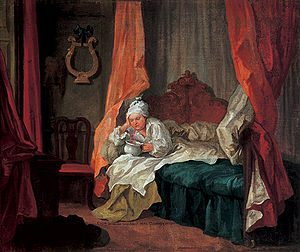
Covent Garden
Covent Garden is a district in London on the eastern fringes of the West End, between St. Martin's Lane and Drury Lane. It is associated with the former fruit and vegetable market in the central square, now a popular shopping and tourist site, and the Royal Opera House, which is also known as...
, were installed in the first floor rooms and bedroom.The floorboards were replaced with old wood, treated with lime and wax, and the ceilings refinished with lime plaster.
Careful research revealed samples of the original 1720s paint on woodwork on the staircase and surviving second floor door, which in its history had been painted 28 times. The original colour was lead grey throughout the house and No. 27/29; the door had been subsequently painted chocolate brown, a colour popular in Georgian times for concealing grime. These are the colours that have been used to redecorate the house, with more grey on the first floor to indicate its importance.
The detailed two page inventory from August 1759, made after more valuable items had been removed, gave a guide to the furnishings of the house. The paired curtains
mentioned in the inventory, although in vogue in the 1720s, had fallen out of fashion by the 1750s. On the first floor the curtains would have been of green silk, but are listed only for the back room; possibly there were none in the rehearsal room in the front for acoustic reasons.
Most of the furniture was in walnut with a few tables in oak. Although none of Handel's original furniture has been found, pieces have been placed in the rooms which adhere as closely as possible to the inventory. The large full tester bed
Four poster bed
A four-poster bed is a bed with four vertical columns, one in each corner, that support a tester, or upper panel. There are a number of antique four-poster beds extant dating to the 16th century and earlier; many of these early beds are highly ornate and are made from oak...
with it crimson harateen hangings has been reconstructed, using a period bed; the woven wool fabric and silk braid for the upholstery and curtains were prepared based on a full tester bed at Hanbury Hall
Hanbury Hall
Hanbury Hall was built by the chancery lawyer Thomas Vernon in the early 18th century. Thomas Vernon was the great grandson of the first Vernon to come to Hanbury, Worcestershire, Rev Richard Vernon...
, Worcestershire
Worcestershire
Worcestershire is a non-metropolitan county, established in antiquity, located in the West Midlands region of England. For Eurostat purposes it is a NUTS 3 region and is one of three counties that comprise the "Herefordshire, Worcestershire and Warwickshire" NUTS 2 region...
. The bed linen, pillows and quilt mentioned in the inventory have been recreated using items from the Historic Royal Palaces
Historic Royal Palaces
Historic Royal Palaces is an independent charity created in 1998 to manage Britain's unoccupied royal palaces. These are:* The Tower of London* Hampton Court Palace* Kensington Palace - the state rooms only.* Banqueting House* Kew Palace...
.
Permanent collection
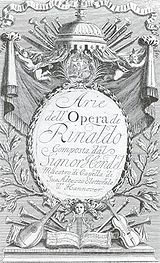
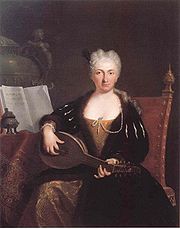
- correspondence of Handel,
- original manuscripts,
- a copy of one of the first biographies of Handel by John Mainwaring, with marginal comments by his friend and librettist Charles JennensCharles JennensCharles Jennens was an English landowner and patron of the arts, who assembled the text for five of Handel's oratorios: Saul, Israel in Egypt, L'Allegro, il Penseroso ed il Moderato, Messiah, and Belshazzar...
, - early editions of operas and oratorios
- prints,
- paintings
- sculptures.
Around the same time the trust also bought two paintings of Jennens (by Thomas Hudson
Thomas Hudson
Thomas Hudson may refer to:* Thomas Hudson , British actor* Thomas Hudson , English portrait painter of the eighteenth century...
) and the opera singer Faustina Bordoni
Faustina Bordoni
Faustina Bordoni was an Italian mezzo-soprano.-Early career:She was born in Venice and brought up under the protection of the aristocratic brother composers Alessandro and Benedetto Marcello. Her singing teacher was another composer, Michelangelo Gasparini...
(by Bartolomeo Nazari
Bartolomeo Nazari
Bartolomeo Nazari was an Italian painter of the late-Baroque, mainly active in Venice as a portraitist.Born in Clusone, near Bergamo. By 1716, he had become an apprentice under Angelo Trevisani, but visited in 1723 the Roman studio of Angelo's brother, the Venetian Francesco Trevisani, and then...
).
During 2009, to mark the 250th anniversary of Handel's death, the Handel House Museum will be mounting a series of special exhibitions and events, entitled Handel Reveal'd. The permanent collection will be supplemented by a large number of paintings and prints connected with the life and work of Handel on loan from other collections in Britain. In addition a rarely seen life mask of Handel by Roubiliac from a private collection will be on display.
The rooms of 25 Brook Street
- Rehearsal and performance room (first floor, front). This was used as a rehearsal room by Handel from the 1730s onwards. It contains portraits of contemporary singers and a reproduction of a two manual harpsichordHarpsichordA harpsichord is a musical instrument played by means of a keyboard. It produces sound by plucking a string when a key is pressed.In the narrow sense, "harpsichord" designates only the large wing-shaped instruments in which the strings are perpendicular to the keyboard...
by the Flemish firm RuckersRuckersThe Ruckers family were Flemish harpsichord and virginal makers based in Antwerp in the 16th and 17th century whose influence stretched well into the 18th and to the harpsichord revival of the 20th.The Ruckers family contributed immeasurably to the harpsichord's technical development,...
. The harpsichord is used for concerts and is also available for rehearsals by musicians from the general public.
- Composition room (first floor, back). This is believed to be the room in which composed some of his most celebrated works, including Messiah. It contains portraits of Handel and Charles JennensCharles JennensCharles Jennens was an English landowner and patron of the arts, who assembled the text for five of Handel's oratorios: Saul, Israel in Egypt, L'Allegro, il Penseroso ed il Moderato, Messiah, and Belshazzar...
, Handel's friend and librettistLibrettoA libretto is the text used in an extended musical work such as an opera, operetta, masque, oratorio, cantata, or musical. The term "libretto" is also sometimes used to refer to the text of major liturgical works, such as mass, requiem, and sacred cantata, or even the story line of a...
of Messiah. This room usually contains a smaller harpsichord; while it is being repaired, a 1749 Joseph Mahoon spinetSpinetA spinet is a smaller type of harpsichord or other keyboard instrument, such as a piano or organ.-Spinets as harpsichords:While the term spinet is used to designate a harpsichord, typically what is meant is the bentside spinet, described in this section...
, similar to the spinet Handel is believed to have owned, is on display, on loan from a private collection.
- London room (second floor, back). This served as Handel's dressing room and was originally connected to a small closet.
- Bedroom (second floor, front). This is probably the room where Handel died. A complete inventory was made within months of his death. Amongst the furniture, it describes a large canopied tester bedFour poster bedA four-poster bed is a bed with four vertical columns, one in each corner, that support a tester, or upper panel. There are a number of antique four-poster beds extant dating to the 16th century and earlier; many of these early beds are highly ornate and are made from oak...
similar to the one now in the room.
Opening hours and events
The house is open to the public six days a week (closed Mondays). The museum has a lively events programme including live music, changing exhibitions, lectures and children's educational events. Several performances of baroque musicBaroque music
Baroque music describes a style of Western Classical music approximately extending from 1600 to 1760. This era follows the Renaissance and was followed in turn by the Classical era...
are staged each month, recitals are sometimes during opening hours, but more usually in the early evening for a separate charge.
23 Brook Street
The museum also incorporates the upper floors of its neighbour, 23 Brook Street, which, in striking musical contrast, was the home of rock guitarist Jimi HendrixJimi Hendrix
James Marshall "Jimi" Hendrix was an American guitarist and singer-songwriter...
in 1968–9. These rooms are used for temporary exhibitions and events. Both houses have Blue Plaque
Blue plaque
A blue plaque is a permanent sign installed in a public place to commemorate a link between that location and a famous person or event, serving as a historical marker....
s for their respective occupants.
External links
- Official website
- Exorcist called to banish ghost in Handel's house, Daily Telegraph
- Handel exhibition suggests his poison was the lead in his wine, GuardianThe GuardianThe Guardian, formerly known as The Manchester Guardian , is a British national daily newspaper in the Berliner format...
- Images:
- The reproduction Ruckers harpsichord in the Rehearsal Room
- The 1749 Thomas Mahoon spinet in the Composition Room
- Handel House organ, St George's, Hanover Square
- Handel's Traeri clavichord, Maidstone Museum
- Bedroom
- Staircase
- Roubiliacs's life mask of Handel displayed by crimewriter Ruth RendellRuth RendellRuth Barbara Rendell, Baroness Rendell of Babergh, CBE, , who also writes under the pseudonym Barbara Vine, is an English crime writer, author of psychological thrillers and murder mysteries....
in Handel's bedroom

